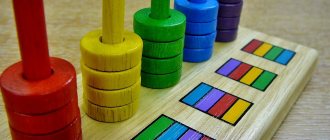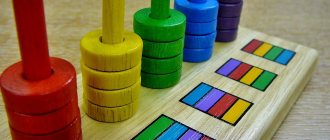10/22/2018 Yulia Shevchenko
General Director of the Perm Center for the Development of Giftedness Yulia Shevchenko took part in a discussion about the engineering thinking of preschoolers at the Leaders of Change forum and spoke about her impressions. We publish her opinion.
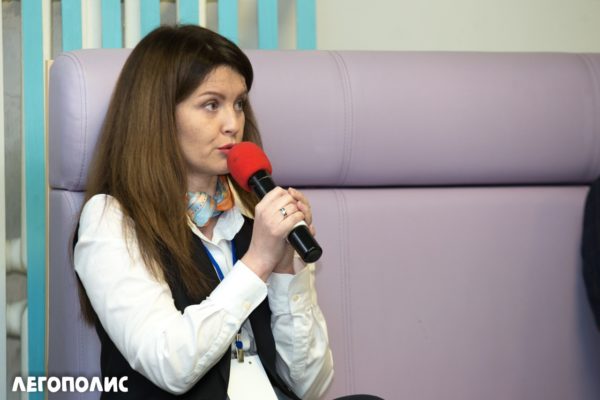
— The topic of the discussion in which I was invited to participate was designated “Engineering thinking of preschoolers.” True, there was a subtitle specifying that the conversation should turn towards the developmental effect of robotics and other types of technical activities available to preschoolers, but somehow it immediately focused on an attempt to separate a whole “nest” of concepts, to identify their boundaries, place and right to exist. This is probably correct: it is difficult to talk about the development of something if you are not sure that it exists or do not understand what the essence of this phenomenon is. Another thing is that meaning and essence are not the easiest subject for “podium” discussions, as they are in forum formats.
Engineering thinking - a process or a property?
Let's start with the main question for discussion about the legitimacy of distinguishing and the essence of engineering thinking. In general, thinking allows us to reflect patterns and cause-and-effect relationships. At the same time, two options are not distinguished in verbal form: thinking as a process of reflecting such patterns and thinking as a property that allows a person to reflect such patterns.
Therefore, a few clarifications. Mental processes are the basis of mental activity. Or, one might say, mental activity (the work of the psyche) is realized in mental processes. Mental properties are some stable characteristics by which people can differ from each other. They represent stable characteristics that determine the effectiveness of a particular process in a particular person. The difference between mental processes and properties (and there are also mental states, but we won’t talk about them now) is not always easy to grasp. Understanding is usually facilitated by the use of physiological analogies. Physiology also has processes and their individual characteristics (and states, but we won’t talk about them). Let's take digestion. In general, this is a certain process that is characteristic of everyone, for simplicity, let’s say, people. But if someone says that due to “weak digestion” he is forced to give up a certain product, he is talking about a property that distinguishes him from other people.
Formation of prerequisites for engineering thinking in preschool children
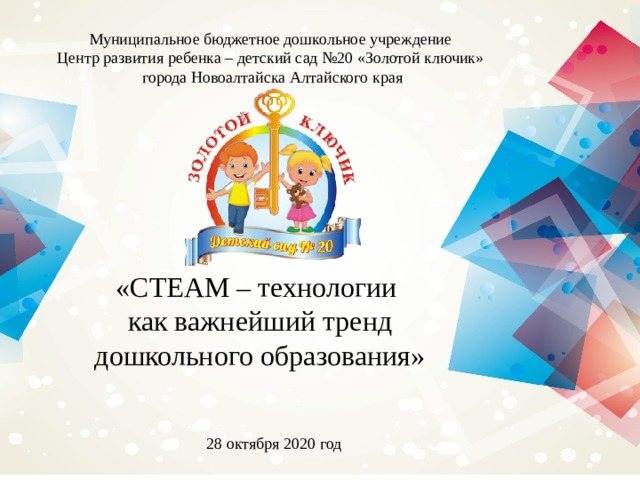
Municipal budget preschool institution
Child development center – kindergarten No. 20 “Golden Key”
city of Novoaltaisk, Altai Territory
"STEAM - technologies
as the most important trend in preschool education"
October 28, 2022
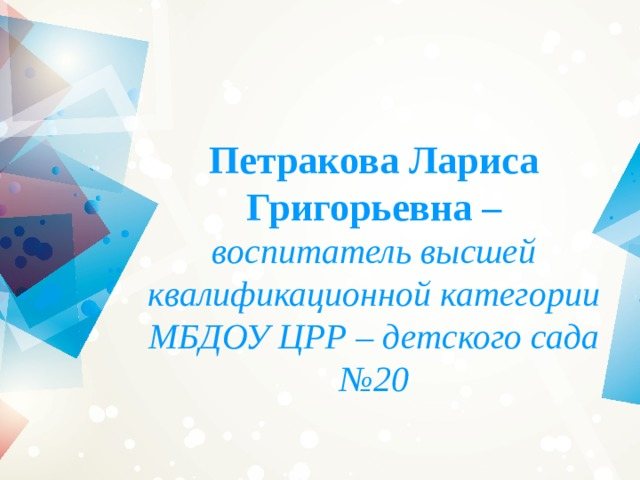
Petrakova Larisa Grigorievna –
teacher of the highest qualification category MBDOU TsRR – kindergarten No. 20
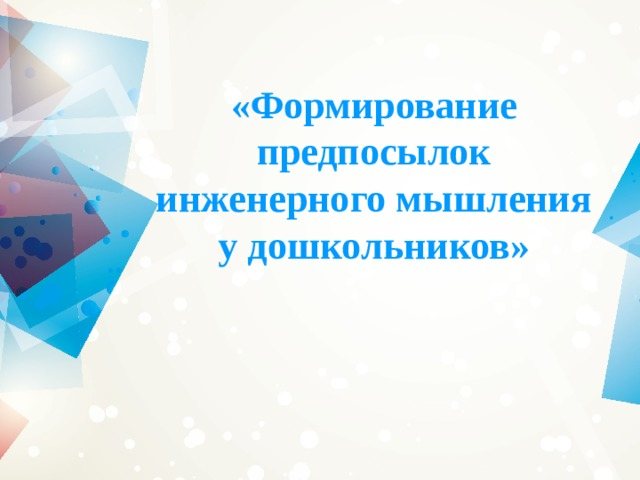
“Formation of prerequisites for engineering thinking in preschool children”
Tasks in forming the prerequisites for engineering thinking
- To develop preschoolers' interest in modeling and design, to stimulate children's scientific and technical creativity.
- To form spatial thinking, the ability to analyze an object, highlight its characteristic features, main parts, and establish a connection between their purpose and structure.
- Develop imagination, fantasy and creative initiative;
- Develop observation, ability to compare, generalize;
- Develop children's cognitive interest in the process of experimentation, establish cause-and-effect relationships, and the ability to draw conclusions;
- Form a holistic picture of the world, broaden the horizons of children.
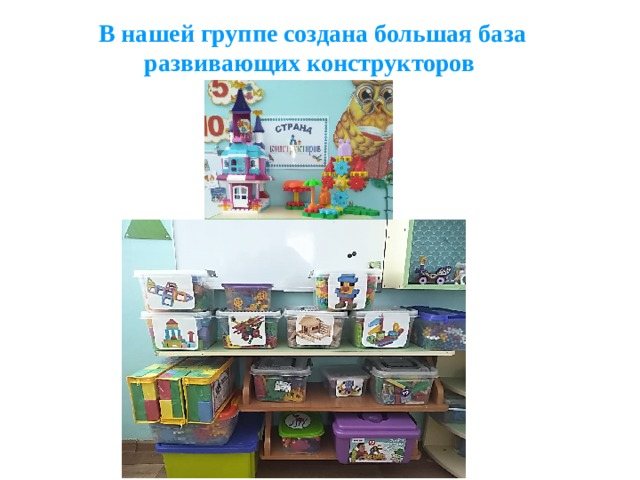
Our group has created a large database of development designers
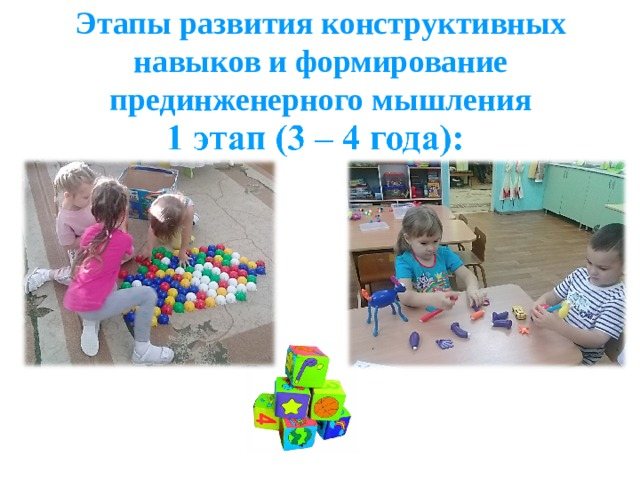
Stages of development of constructive skills and the formation of pre-engineering thinking
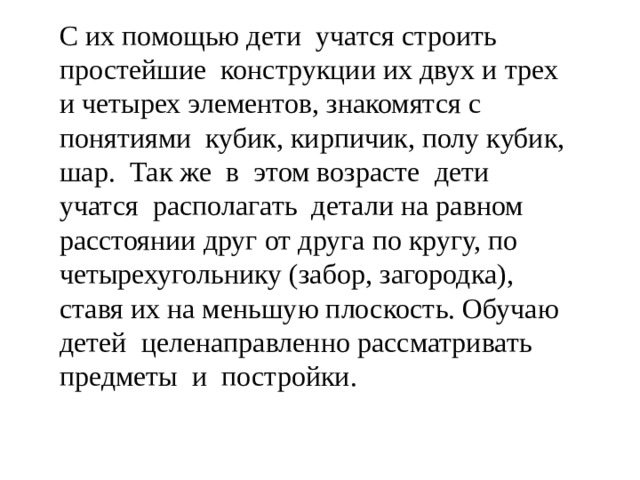
With their help, children learn to build the simplest structures of two, three and four elements, and become familiar with the concepts of cube, brick, half cube, and ball. Also at this age, children learn to place parts at equal distances from each other in a circle, along a quadrangle (fence, fence), placing them on a smaller plane. I teach children to purposefully examine objects and buildings.
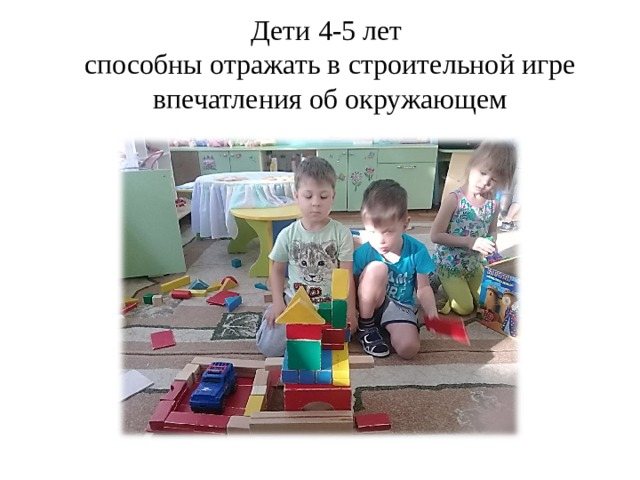
Children 4-5 years old
are able to reflect impressions of the environment in a construction game
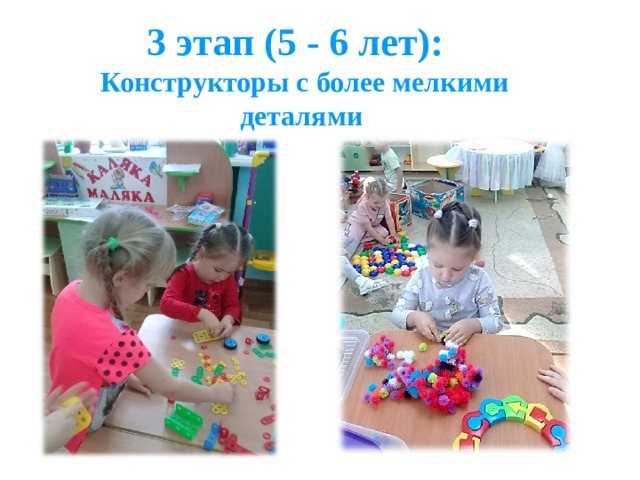
Stage 3 (5 - 6 years):
Constructors with smaller parts

Stage 2 (4 – 5 years):
Design based on a sample.
This is an important educational stage, where it is possible to solve problems that ensure the transition of children to independent search activities of a creative nature.
Here we have developed technological maps with sample models, both simple and more complex.
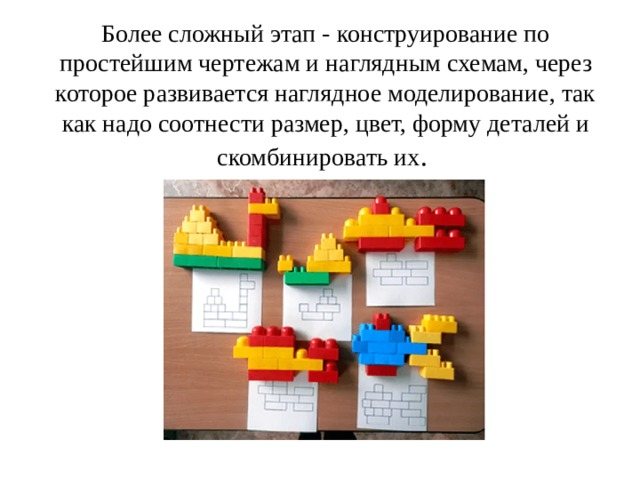
A more complex stage is design using the simplest drawings and visual diagrams, through which visual modeling develops, since it is necessary to correlate the size, color, shape of parts and combine them.
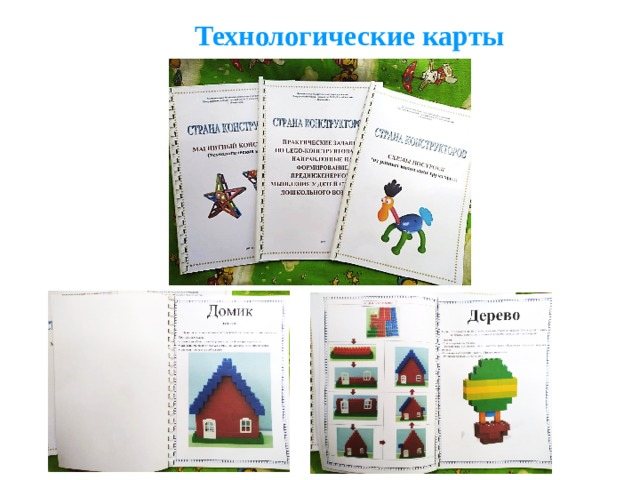
Technological maps
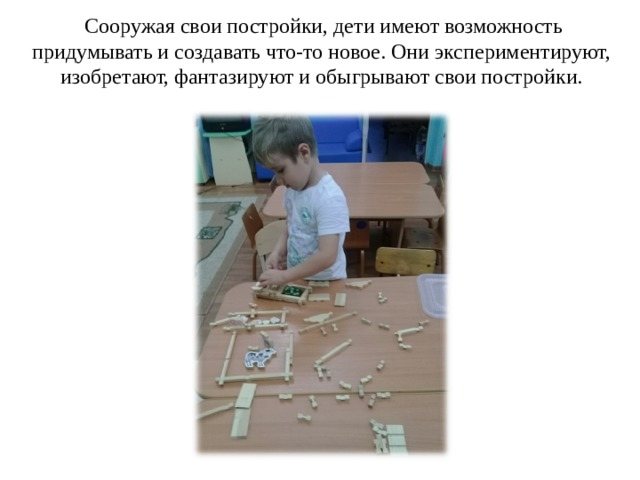
By constructing their buildings, children have the opportunity to invent and create something new. They experiment, invent, fantasize and play with their buildings.
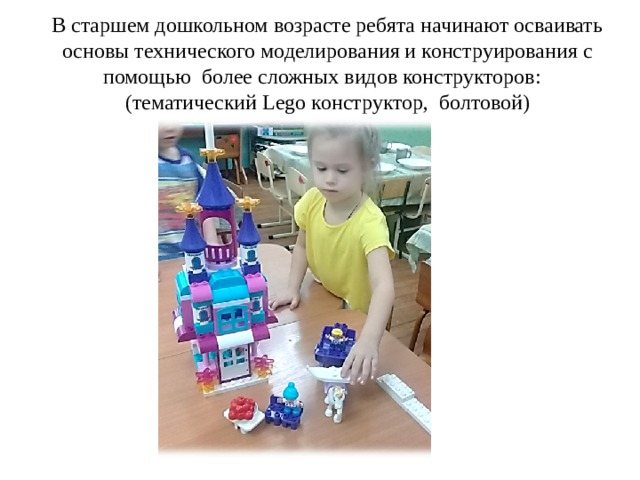
In older preschool age, children begin to master the basics of technical modeling and design using more complex types of construction sets: (Lego themed construction set, bolt-on construction set)
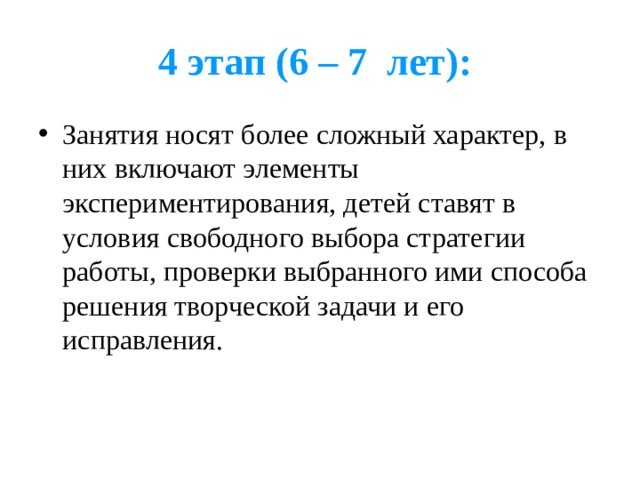
Stage 4 (6 – 7 years):
- The classes are more complex, they include elements of experimentation, children are placed in conditions of free choice of work strategy, testing their chosen method of solving a creative problem and correcting it.
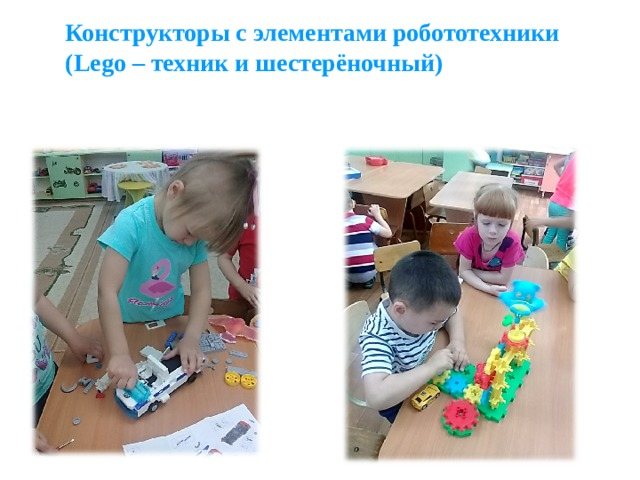
Construction sets with robotics elements
(
Lego - technician and gear)

The formation of engineering thinking plays an important role in the development of a child. In the process of constructive activity, knowledge, skills and abilities are easily acquired.
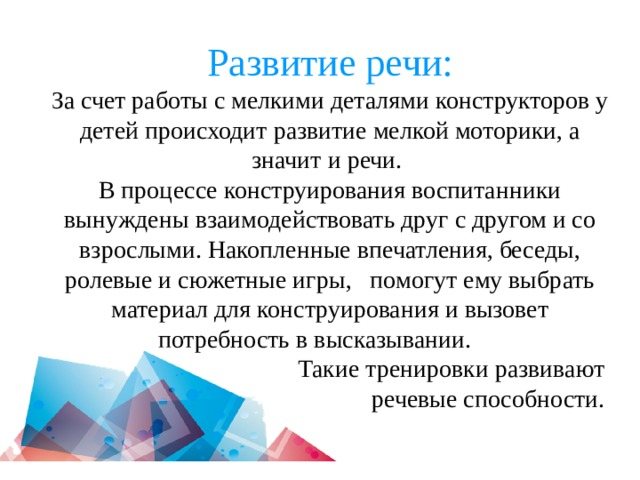
Speech development:
By working with small parts of construction sets, children develop fine motor skills, and therefore speech.
During the construction process, students are forced to interact with each other and with adults. Accumulated impressions, conversations, role-playing and story games will help him choose material for construction and create a need for expression.
Such training develops
speech abilities.
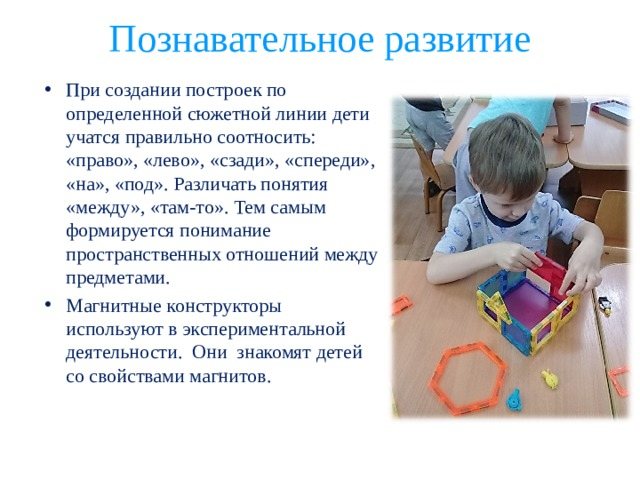
Cognitive development
- When creating buildings according to a certain storyline, children learn to correctly correlate: “right”, “left”, “behind”, “in front”, “on”, “under”. Distinguish between the concepts “between” and “there”. Thus, an understanding of the spatial relationships between objects is formed.
- Magnetic constructors are used in experimental activities. They introduce children to the properties of magnets.
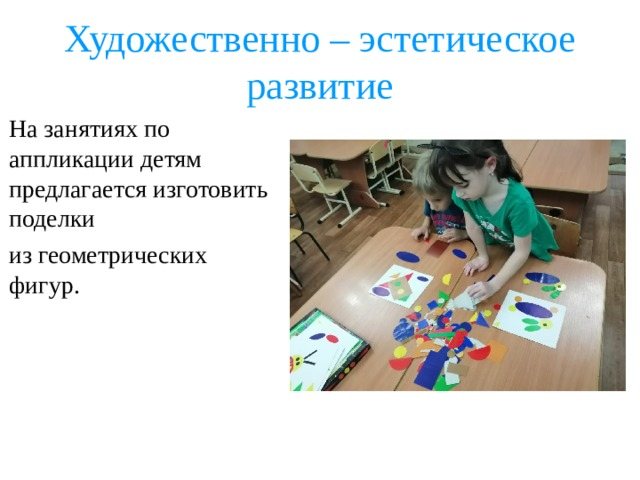
Artistic and aesthetic development
During appliqué classes, children are encouraged to make crafts
from geometric shapes.
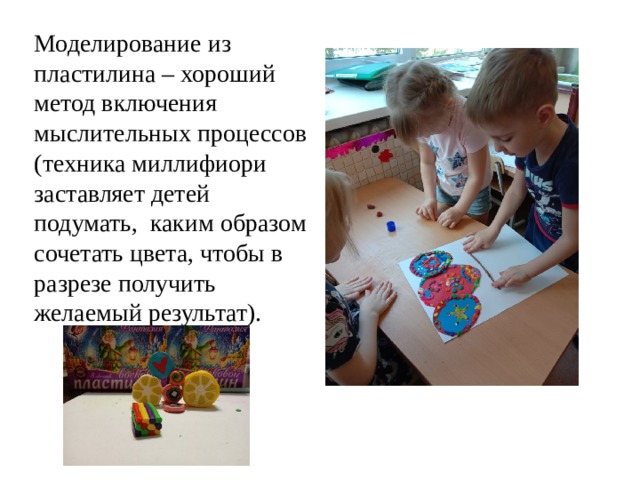
Modeling with plasticine is a good method of engaging thought processes (the millifiori technique forces children to think about how to combine colors to get the desired result in cross-section).
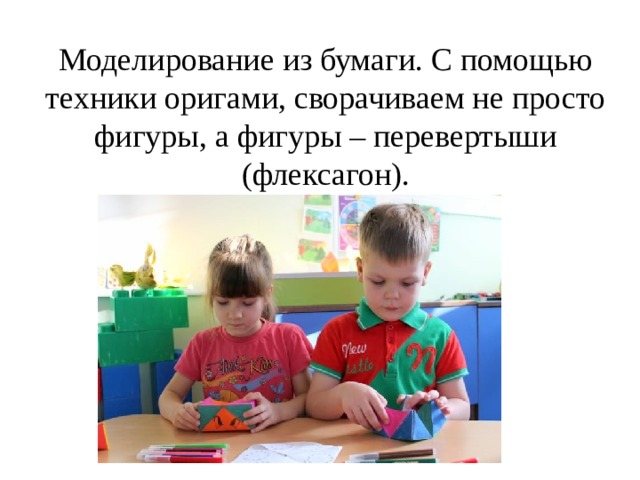
Paper modeling. Using the origami technique, we fold not just shapes, but shapes - inversions (flexagon).
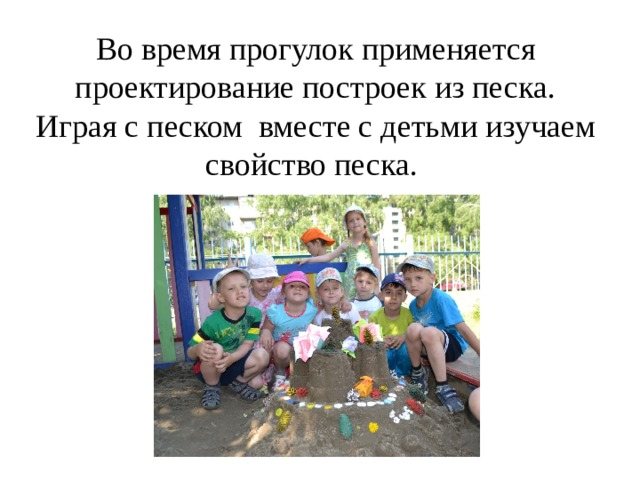
During walks, the design of sand buildings is used. Playing with sand with children, we study the properties of sand.
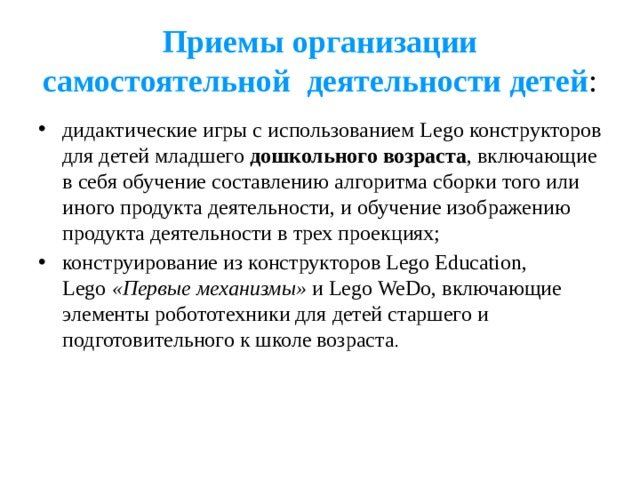
Techniques for organizing children's independent activities
:
- didactic games using Lego constructors for children of primary preschool age
, including learning to draw up an algorithm for assembling a particular product of activity, and learning to depict the product of activity in three projections; - construction from Lego Education, Lego “First Mechanisms”
and Lego WeDo constructors, including elements of robotics for older and pre-school children.
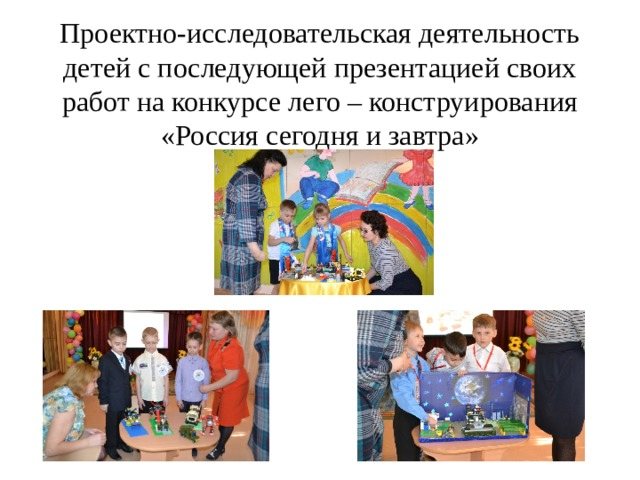
Design and research activities of children followed by presentation of their works at the Lego construction competition “Russia Today and Tomorrow”
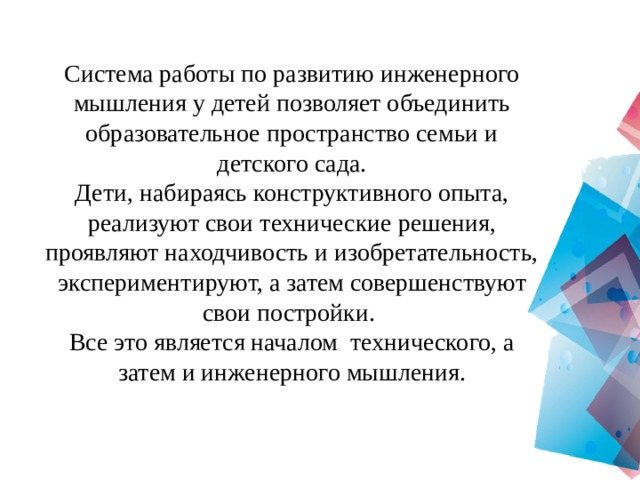
The system of work to develop engineering thinking in children allows us to combine the educational space of the family and kindergarten. Children, gaining constructive experience, implement their technical solutions, show resourcefulness and ingenuity, experiment, and then improve their buildings. All this is the beginning of technical and then engineering thinking.
Engineering thinking for everyone?
One of the questions that was repeated several times yesterday was whether engineering thinking is inherent in everyone, or is it a gift of a select few (sounded in the context of “is it necessary to work with everyone?”). Here I will use an analogy again. Does everyone have logical thinking? If we consider it as a procedural characteristic, then the answer is clear: of course. Thinking is logical by nature, this is its integral characteristic, but when we say about someone “he has wonderful logical thinking!”, We are pointing to special properties, some property that distinguishes one person from others. Therefore, in practice the concepts of “developed logical thinking”, “weak logical thinking”, etc. are used.
The difficulty with engineering thinking is that the legitimacy of its identification is not so obvious, although this concept has been introduced both into the scientific field and into applied contexts, and of course, for the first time it was not heard in “recent documents from the Department of Education,” as was mentioned yesterday. The need for it arose when it was not possible to explain by the work of other aspects of thinking the possibility of solving problems of a certain type - engineering problems. Let's take a trivial one: you need to pull out a small ball that has rolled into a very narrow gap between the sofa and the floor. If we have an object that looks like a stick, this sets one level of the problem. What if there is no mop, but only sheets of paper, or only a plastic bottle, or, say, only a banana? Relying only on logical, mathematical, or artistic thinking, it is impossible to solve such a problem. And, if we try to imagine, visualize what is happening in our heads when we are looking for a way to cope with this difficulty, most likely we will see something special, similar to diagrams from physics textbooks. Therefore, I personally support the opinion that specific engineering thinking does exist. Different researchers describe the characteristics unique to engineering thinking in different ways. I personally really liked the statement from some relatively recent popular science article that engineering thinking allows you to see structures and act under constraints. I think the article stated that it was from the book Think Like an Engineer. The book doesn't have very good reviews on Ozone, but it looks like I wanted to form my own opinion.
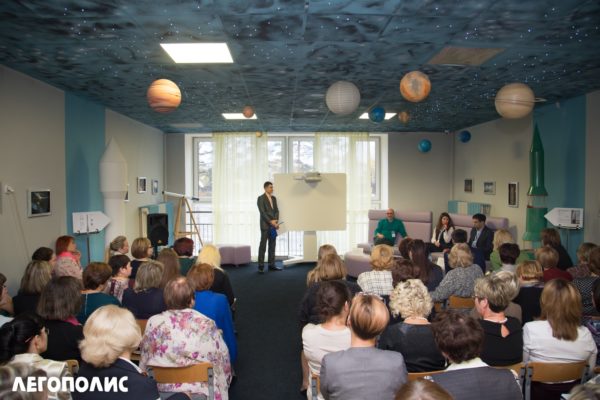
MAGAZINE Preschooler.RF
Development of prerequisites for engineering thinking in preschool children in a kindergarten- Ananyeva Elena Vladimirovna
- Skvortsova Yulia Vladimirovna
Teachers of MKDOU d/s No. 428, Novosibirsk, Novosibirsk region
Recently, there has been active talk about propaedeutics of engineering education for preschool children in preschool educational institutions. There are reasons for this: the designated modern vector of development of society is aimed at the transition to a new technological structure, which requires the formation of an individual ready to live and work in qualitatively new conditions, which do not come down to the ability to master and operate constantly improving equipment and technologies, but require the ability to cope with a set of new production tasks - design, engineering, technological, management...
Modern realities show a gradual annual increase in the number of children with disabilities in preschool organizations. Statistics from 2022 indicate that 4.5% of examined children in Russia have developmental anomalies, of which: disabled children - 580 thousand, children with disabilities - 751 thousand. No more than 10% of preschool children can be considered absolutely healthy. Children with disabilities require special organization of education, when the methods of forming activities are adequate to the level and capabilities of the children.
Recently, the paradigm of modern preschool education has changed significantly. New regulatory documents have been published: Federal Law dated December 29, 2012 No. 273-FZ “On Education in the Russian Federation” , “Federal Educational State Standard of Preschool Education” dated October 17, 2013 No. 1155, which guides us towards “personal development of preschool children age in various types of communication and activities, taking into account their age, individual psychological and physiological characteristics... and is implemented in the following types of activities specific to preschool age: such as play..., construction from different materials..."
Therefore, one of the priority tasks of a modern preschool educational institution is the creation of organizational and content conditions that provide equal opportunities for the formation of prerequisites for engineering thinking in preschool children, regardless of their level of development, gender, nation, language, social status, psychophysiological and other characteristics.
In our kindergarten, a model has been developed to form the prerequisites for engineering thinking in children in accordance with their individual developmental characteristics through scientific and technical creativity. Having been working in this area for four years now, we can say with confidence that the declared model is effective.
The novelty of this model is that it is transformable, depending on the interests and capabilities of the children, on the goals and objectives that the teacher sets for himself. It is implemented in the system, in a combination of such activities as Lego - construction, modeling from the Tico constructor, Bee-Bot programming, the formation of elementary mathematical representations through Cuisenaire's counting sticks and Dienesh's logical blocks, work in the "System Operator" . It is noteworthy that this program is available to any preschool institution, as it does not require large financial costs.
The Program is being implemented within the educational field - cognitive development. The pedagogical council decided to carry out direct educational activities on design in accordance with this program.
Classes are held twice a week, once as part of the educational activity design, the second time as a joint activity between the teacher and the children. Duration of classes according to SANPIN No. 26 dated May 15, 2013: in the middle group - 20 minutes, in the senior group - 25 minutes, in the preparatory group - 30 minutes. The number of children in a group is no more than 12.
During classes, the teacher uses different forms of organizing activities with children: frontal, group, individual, independent.
This program implies the following structure of educational activities:
- presentation of new material (presentation and explanation of new material both verbally, the classical teaching method, and using ICT);
- setting a learning task - in the form of stimulating dialogue;
- discussion and analysis of the task;
- practical search for a solution to the problem;
- reflection (presentation and analysis of the obtained result of productive or research activity);
- playing with buildings, exhibition of works.
The basic rules for conducting classes under the Program are as follows: the child is an active participant in the process, not a teacher, and the children help and teach each other; a special, developmental, informational subject-spatial environment is needed; the ability for children to independently choose a building model; self-control and identification of errors by the child himself; development and observance of certain rules of behavior in the classroom; creation of means of pedagogical support for the child.
The main methods of working on the program: cognitive, problem-based, project method, systematizing, control method.
The model we have developed allows us to effectively use different forms of interaction with parents. The most interesting form of master classes turned out to be when parents come up with a model at home together with their child, and in a kindergarten group they teach preschoolers to construct a structure they have invented.
This program is based on the principles of the Federal State Educational Standard of Education dated October 17, 2013 N 1155 and is presented on the website http: //ds428nsk. edusite. ru/
In addition to this program, there are methodological developments of lesson notes, card files of games, diagrams, “Album of scientific and technical creativity of children” , “Notebook for young inventors” .
From the experience of my teaching activities, I can say with confidence that the content of the subject-development environment is very important; children should have enough types of different construction sets, building diagrams, and additional toys to play with the constructed models.
As a result of the implementation of the model we propose, children develop at their own rhythm and in accordance with their own interests, consolidate fundamental mathematical concepts, and become familiar with the basics of design and modeling. They develop analytical and strategic thinking; attentiveness, hard work, dexterity, perseverance, endurance; creative, logical, visual and imaginative thinking, pre-engineering thinking develops; spatial imagination is trained; speech develops. Children learn to work with information, find it, analyze it, record it, compose and write down an algorithm, sketch diagrams, and fill out tables. They know how to work consistently in a team, observing internal discipline, which is expressed in the ability to accept the rules of the group and respect the activities of others.
| Next > |
What is engineering thinking?
During the discussion, the opinion was also voiced that engineering thinking is a concept in the same category as “culinary thinking,” “hairdressing thinking,” etc. (sounded in support of the thesis “there is no need to create entities, so you can come up with any kind of thinking”). Well, if someone tells me about a special type of culinary or hairdressing problems that cannot be reduced to mathematical, artistic or engineering, but on the contrary - universal, arising and solved in various types of practical/professional activities, then I will definitely agree that such an “idea” will be good and scientifically substantiated. When it comes to engineering problems that require us to use specific cognitive skills, they are all around us. Engineering thinking may be required if you need to open a jammed lock, get a kitten out of a tree, put on tight shoes without special equipment, iron one sleeve of a shirt without creasing the previous one, attach a bag to an uncomfortable back of a chair at a conference, and so on ad infinitum. Engineering problems are regularly faced by professionals and amateurs in the field of cooking or hairdressing.
It will not be possible to integrate engineering thinking into the series “visual-effective - visual-figurative - verbal-logical”. The concept of “engineering thinking” does not correspond to the concept of “abstract thinking”, where they tried to place it. The relationships between these phenomena are completely different. The fact is that, in essence, visual-effective, visual-figurative and verbal-logical thinking is, rather, not classification categories, but a chain of mental new formations that open up new opportunities for us in the course of development (both individual and evolutionary). The “field of objects” in which we can solve problems of different types is gradually expanding. At first we can solve mental problems only on the basis of manipulating material objects, then by working with images, then by using abstractions. It's the same story with engineering problems. Doesn’t a child who is looking for support, mastering upright walking, or a baby trying to overcome the ingenious mechanisms of “child protection” encounter them? And although visual-effective, visual-figurative and verbal-logical thinking are most often called types, more accurate, in my opinion, is another conceptual construct: thinking at different levels. And then we can talk about engineering thinking, which can be implemented at three different levels. At the same time, it is important not to forget that the transition to a new level does not reduce the significance of previous achievements. After all, any tool must be used rationally. If it is important for us to quickly get the ball out from under the sofa, and we have a mop with a long handle of a suitable diameter at hand, it would be irrational to create a design for a mechanical arm or carry out complex calculations describing the mechanics of the interaction of the mop, the floor, the sofa, the ball and our own body, taking into account the draft and thermal characteristics of the room.
Features of the development of engineering thinking in preschool children
Preschool age is an important period for the development of all mental functions: speech, thinking, emotions, mechanisms for controlling voluntary movements, for which the higher structures of the brain are responsible - the cortex. It's all about the game. The mental development of preschool children is characterized by the formation of figurative thinking, which allows him to think about objects and compare them in his mind even when he does not see them. However, logical thinking has not yet formed. This is hampered by egocentrism and the inability to focus on changes in the object.
In the development of a preschooler’s thinking, a significant role is played by children’s mastery of methods for visually modeling certain phenomena. Visual models, in which essential connections and relationships of objects and events are reproduced, are the most important means of developing a child’s abilities and the most important condition for the formation of an internal, ideal plan of mental activity. The emergence of a plane of visual representations of reality and the ability to act in terms of images (internal plane) constitute, according to Zaporozhets A.V., the first, “ground floor” of the general edifice of human thinking. It is laid down in various types of children's activities - in play, design, visual arts and others [3,5].
The ability to use model images in thinking, which begins to develop in children of 3–4 years of age, becomes in older preschool age the basis for understanding the various relationships of objects, allows children to assimilate generalized knowledge and apply it when solving new mental problems. This ability is manifested in particular in the fact that children easily and quickly understand schematic images offered by adults and use them successfully. Starting from the age of 5, preschoolers, even without special explanation, understand what the floor plan is and, using the mark on the floor plan, find a hidden object in the room. They recognize objects well in schematic images, successfully use path diagrams, etc. [2].
Psychological and pedagogical research has established that in organizing the acquisition by older preschool children of knowledge about space, about the phenomena of living and inanimate nature, in teaching them the basics of mathematics and literacy, and in other types of education, the use of visual models is especially effective. Working with visual models, children easily understand relationships between things and phenomena that they are unable to learn either on the basis of verbal explanations or when acting with real objects. Thus, when teaching mathematics, the model of quantitative relations helps children determine these relations from other properties of objects and master the idea of number, and the model of the relationship between part and whole helps them understand the meaning of the operations of addition and subtraction [8].
Nowadays, the technical complexity of means of production is constantly increasing, which requires special attention to the professional intellectual qualities of the engineer, as well as to his creative abilities.
Engineering thinking is understood as a type of cognitive activity aimed at researching, creating and operating new high-performance and reliable equipment, advanced technology, automation and mechanization of production, and improving product quality. The main thing in engineering thinking is the solution of specific tasks and goals put forward by production using technical means to achieve the most effective and high-quality result. At the same time, rationalization, invention and discovery as the results of scientific and technical creativity generate qualitatively new results in the field of science and technology and are distinguished by originality and uniqueness.
Modern engineering thinking is deeply scientific, therefore it is necessary to highlight pre-engineering thinking as the basis for the formation of engineering thinking. Let us highlight the following signs of pre-engineering thinking:
- is formed on the basis of scientific and technical activities, such as thinking about construction from Lego, etc.;
- rationally, expressed in a publicly accessible form as a product;
- has no tendency towards formalization and standardization, relies only on experimental and design base;
— systematically formed in the process of scientific and technical creativity;
- tends to universalize and spread to all spheres of human life [1,4].
The structure of pre-engineering thinking includes rational, sensory-emotional and axiological elements, memory, imagination, fantasies, abilities, etc. The level of development of pre-engineering thinking can be assessed:
Table 1
Pedagogical assessment of the formation of pre-engineering thinking of a preschool child
| Criteria | Indicators | Manifestation of the indicator | ||
| Formed | In the formative stage | Not formed | ||
| Interest and desire to design | Choosing a design for joint and/or independent activity by a preschool child | Chooses design first for both joint and independent activities | Chooses design more often for joint activities, rarely for independent activities | Does not show interest in construction, does not choose independently, rarely joins an adult or children playing |
| Abilities and ability to design | -reaction to the task; — selection of materials, methods of activity; — the result of the activity | The product of activity reflects all indicators of children's technical creativity, there are signs of originality | The product of activity reflects diagrams, models, samples | The product is created only through joint activities using a sample |
| Presence and development of cognitive abilities | Development of constructive, mathematical, logical abilities | Complete tasks accurately, independently, creatively | Needs help, makes mistakes when working with a model, diagram, shows a desire to achieve results | Does not strive for results, often makes mistakes, manipulates the designer without correlating the actions and results with the sample, diagram, model |
The rudiments of engineering thinking are necessary for a child from an early age, since from early childhood he is surrounded by technology, electronics and even robots. This type of thinking is necessary both for studying and operating technology, and for preventing the child’s “immersion” in the technological world (learning from an early age to explore the chain “button - process - result” instead of learning to simply and thoughtlessly “press buttons”). The child should also gain an understanding of initial modeling as part of scientific and technical creativity. The basics of modeling should be naturally included in the child's development process in the same way as the study of shape and color [6,9].
The opportunity to develop does not remain unchanged. Every child is born with a rich fibrous network connecting brain cells. At an early stage of development, brain cells need not only adequate nutrition, but also sufficient stimulation. Neural connections are strengthened only when certain nervous structures are activated, when certain abilities begin to function, causing the passage of biocurrents along the “lines of communication.” Neurons deprived of nutrition or a stimulating “learning” environment cannot form an extensive network and eventually atrophy. Therefore, the younger the child, the easier the formation of connections occurs. And with age this happens more and more difficult. Boris Nikitin (a famous Russian teacher) called this phenomenon NUVERS - the irreversible extinction of opportunities for the effective development of abilities [7].
As you can see, early development is determined both physiologically and by social needs - children who had a high level of development before starting school did not experience difficulties in this subsequently.
Sometimes before children enter first grade, they are given several psychological tests, based on the results of which classes of different levels of training are formed. Children often differ very strikingly from each other in terms of development. Why is there such a difference? Scientists studied younger preschoolers more than 20 years ago and were convinced: the younger the children were, the closer they were in development. Therefore, if you want your child to achieve high results at school age, you need to start developing it as early as possible. Moreover, the result of pedagogical influences on him in the future (for example, with the aim of developing engineering thinking) depends on the level and quality of the child’s “basic” thinking.
table 2
Levels of development of engineering thinking in a preschool child
| Criteria | Indicators | Levels | ||
| optimal | sufficient | inadequate | ||
| Desire to design | Choosing the most appropriate type of activity for a preschool child | Selects construction as the first of the proposed activities | Selects the design of the second of the proposed types activities | Selects construction as the third of the proposed activities |
| Ability to design | —reaction to the task; — the result of the activity; — selection of materials; -originality | The product of activity reflects all indicators of children's creativity products | The product of activity reflects half of the indicators of children's creativity products | The product of activity reflects few indicators of children's creativity products |
| Level of formation of educational features | Development of constructive mathematical and logical abilities | Complete tasks without error, independently | Needs help, makes a lot of mistakes | Doesn't respond, does everything wrong, often makes mistakes |
In addition, the rudiments of engineering thinking are necessary for a child from an early age, since from early childhood he is surrounded by technology, electronics and even robots. This type of thinking is necessary both for studying and operating technology, and for preventing the child’s “immersion” in the technological world (training from an early age to explore the “button - process”
- result” instead of teaching simple and thoughtless “pressing buttons”). The child should also gain an understanding of initial modeling as part of scientific and technical creativity. The basics of modeling should be incorporated naturally into a child's development, just as learning about shapes and colors should be.
The formation of the child’s personality traits, his physical and intellectual abilities through targeted pedagogical influence should be carried out consistently and continuously.
The preparatory stage of development, the “advanced” intellectual and creative development of a child, is considered as an important prerequisite for the formation of engineering thinking in a teenager.
Literature:
1. Volkova S. I. Design - M: Education, 2010.
2. Vygotsky L. S. Pedagogical psychology. - M., 1991.
3. Dubrovina I.V., Danilova E.E., Prikhozhan A.M. Psychology. 2nd ed., erased. - M.: Academy, 2003–464 p.
4. Kochkina N. A. Organizational and methodological foundations for planning educational activities // Management of preschool educational institutions. - 2012. - No. 6. - P. 24.
5. Leontyev A. N., Zaporozhets A. V. Questions of psychology of a preschool child: Sat. Art./Ed. Leontyev A.N. and Zaporozhets A.V. - M.: International Educational and Psychological College, 1995. - 144 p.
6. Meerovich, M. I. Technology of creative thinking: A practical guide Text. / M. I. Meerovich, JI. I. Shragina // Library of practical psychology. - Minsk: Harvest, 2003. - 432 p.
7. Nikitin B.P. Steps of creativity or educational games. - M.: Education, 1991.
8. Ponomarev Ya. A. Knowledge, thinking and mental development. - M., 1967.
9. Teplov B. M. Practical thinking // Reader on general psychology: Psychology of thinking. - M.: MSU, 1981.
Technical creativity or engineering thinking?
Now about the relationship between the concepts of “technical creativity” and “engineering thinking”. It would seem that everything is simple here, but we have to stop at this point, because we ended up facing a funny situation. During the discussion, a completely understandable idea was voiced that thinking is an abstract thing, it is easier to discuss what can be seen and touched - technical creativity. I remembered: “And the head is a dark object and cannot be examined.” You can’t argue: creativity is indeed easier to discuss. And after the meeting ended, we read the following response on the feedback board: “in the end, I realized that young children cannot have engineering thinking, but only technical creativity”... I hope the author of the response will read this note, including the following thesis. Creativity is an activity. During its course, various mental manifestations are involved: sensations, perception, attention, memory, imagination, emotions, will and, of course, thinking of different types and different levels. The leading type of thinking in most cases will be determined by the nature of creative activity, but will not always be limited to it. For example, engineering thinking can be involved in the process of artistic creativity: for example, when creating many sculptures, complex engineering problems are solved. It could probably be the other way around: but I haven’t come up with a beautiful and obvious example yet.
Since we have already started to understand, let’s try to separate all the concepts of this field. How are thinking and intelligence related? If thinking is fundamentally procedural, then intelligence is a quality, a property in its pure form. Moreover, in contrast to “good/lively/fast/accurate thinking” (which, as we said above, is also a property), intelligence is a more complex property: its content contains not only the speed and efficiency of cognitive operations, but also other characteristics (this “filling” is described differently by different concepts of intelligence). It is likely that engineering intelligence and engineering thinking are related in a similar way.
Abilities and giftedness
In addition, there is also the concept of engineering abilities. In general, abilities and talent characterize a person from the point of view of his ability to achieve success in general intellectual or in some specific activity. At the same time, according to Teplov’s clarification, abilities should not be reduced to knowledge, skills and abilities. Abilities are some private, specific properties. These may be, for example, characteristics of mental processes that have become individual characteristics (good logical thinking, vivid imagination, stable attention, a special angle of perception (“I’m an artist, I see this”), or there may be some qualities that are largely determined by physiologically: hearing, sense of rhythm, eye. Talent, according to the sources that have received the most recognition, is an integral phenomenon, the important components of which are the cognitive component, creativity and motivation. Thus, high engineering intelligence or “good” engineering thinking is part of the content of a special type special talent.
Engineering or technical?
It seems that I described all the concepts that I wanted... and now I admit: for me, there remains one difficulty in this whole concept: to clarify which adjective is more correct in the names of all these cognitive phenomena: after all, “engineering” or still “technical”. It’s good that we didn’t get to this issue yesterday.
And, to finish with the psychological issues raised yesterday, I can’t resist and quickly refute a number of theses that were voiced at the event. In fact, there is no scientific data that reliably proves that the possibilities for the manifestation of engineering thinking, intelligence, abilities, or the potential for achieving success in technical activities are limited by temperamental characteristics, the organization of the work of the cerebral hemispheres, or gender-related characteristics of human psychophysiology.
I will only add that insofar as it did not concern essential issues, the discussion, in my opinion, turned out to be complete and was quite successful: we lagged behind different positions, found common ground, were emotional, caring and ready for mutual understanding. For all this, thanks to the organizers, fellow speakers, moderator, experts and all participants!
Photo: Legopolis kindergarten.


